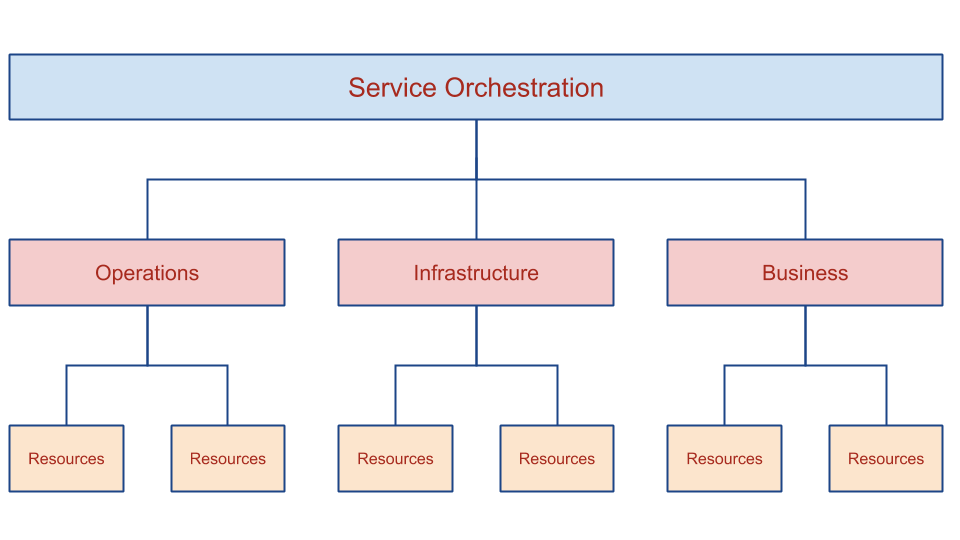Service orchestration is reshaping IT – Here’s what to know
Service orchestration tools provide the extensibility and monitoring necessary for IT teams to streamline end-to-end data processes. Read more here.

What is service orchestration?
Service orchestration refers to the unified management of IT services and resources in order to streamline end-to-end IT and business processes.

A service orchestration platform sits at the top of the IT stack, abstracting complexity away from individual systems and environments. This enables IT departments to easily manage processes, monitor resources, and to string discrete tasks into end-to-end processes from a single point of control, without having to rely on custom scripting.
Why is service orchestration important?
Modern IT processes manage data across platforms, systems, and environments that are built using different technologies from different vendors. Traditionally, these tools and systems have existed in silos managed by personnel with narrow, but very deep expertise. These high-level personnel would then have to research, develop, and test custom scripts to create a cross-platform process.
This method is time-consuming and prone to errors, and even with scripts in place IT must rely on a number of manual triggers and handoffs. In an era of real-time data, heightened consumer expectations, and fluid business goals, manual methods and custom scripts are unable to provide the flexibility and speed that organizations require.
Computing environments have been trending towards higher levels of abstraction since, well, before FORTRAN. IT environments in the last 20 years have become increasingly diverse and complex, making a new level of orchestration capabilities necessary to simplify and streamline those environments.
Benefits of service orchestration
Service orchestration platforms are designed to unify the management of disparate processes and systems, across on-premises and cloud-based environments. This is done with the help of universal connectors and web services APIs that make it easy to manage data and dependencies across those disparate tools and environments, without the need for additional scripting.
By providing a single tool to develop end-to-end processes, IT teams are able to centralize the management and monitoring of those processes and associated resources. Real-time monitoring and auto-remediation tools can be used to avoid delays and failures in IT service delivery, while in-depth views and reports make it easier to identify usage patterns and to optimize machine resources.
There is a long list of benefits that IT can achieve through service orchestration. Those key benefits include:
- Improved SLAs – When there are delays, overruns, underruns, or failures, IT has a single location through which to identify the root cause, as opposed to checking multiple tools. This can drastically improve response times. Additionally, the service orchestration platform can reserve and provision resources to ensure that SLA-critical workflows complete on time.
- Rapid DevOps – Drag-and-drop workflow designers make it easy for IT to develop reliable new services and end-to-end processes. Instead of scripting connections between tools, APIs and existing scripts can be ingested and transformed into reusable components which in turn can be drag-and-dropped into end-to-end workflows.
(As an added benefit, look for solutions that simplify service lifecycle management with automated documentation, revision history, and change management.) - Operational Peace of Mind – Service orchestration tools are designed to simplify IT environments. This includes reducing the time IT has to spend fighting fires by providing auto-remediation capabilities, monitoring, and timely alerting. If a job or workload is at risk of failure, the orchestrated service platforms can automatically execute a remediation workflow or send alerts to the appropriate IT teams and systems.
- Greater Efficiency and Cost Savings – With universal connectors and API accessibility, IT can automate more and manually manage less. Service automation mean that IT professionals can focus more on higher-value projects such as innovative new business services and digital transformation initiatives.

Cloud orchestration for hybrid IT
Public cloud providers (including Amazon AWS, Microsoft Azure, Google Cloud, VMware, etc.) often do not offer integrations with competing cloud platforms/cloud services. This vendor lock-in makes it difficult for IT to manage data across hybrid cloud and multi cloud environments.
Because of the radical extensibility offered by service orchestration platforms, these tools have become ideal for IT teams looking to simplify cloud management across multi-vendor environments.
Aside from integrating cloud-based processes, service orchestration tools are being used to manage IT infrastructure, automating the provisioning and deprovisioning of virtual machines. If a process or workflow requires additional resources, the service orchestration tool can provision the necessary cloud infrastructure, and then deprovision those same servers once the workload is complete. This saves IT time by preventing the need for manually managing resources, and reduces operational expenses by reducing idle machine resources.
Additionally, some service orchestration tools are applying machine learning (ML) algorithms to historical runtime data. These algorithms identify trends and patterns in resource usage, optimizing the allocation of resources for future runs.
Service orchestration examples
Service orchestration platforms include several technologies that have overlapping capabilities – extensibility, low-code automation, and centralized monitoring. As a result, service orchestration can be achieved through a variety of IT automation tools, including service orchestration and automation platforms (SOAPs), workload automation solutions (WLA), and enterprise job scheduling platforms.
Regardless of the underlying framework, these tools can support a wide range of operating systems, mainframes, databases, and software applications. This makes it possible to streamline data from the data center to the end-user, such as a claims adjuster or a customer accessing his or her banking information.
Example #1: Imagine that a financial services provider has built a new online portal that can be accessed through a web browser or a smartphone app. If a new or existing customer wishes to get a quote for a loan, or a mortgage, a new credit card, the customer will need to first enter some information.
When the customer hits submit, the service orchestration platform can kick-off an ETL process that moves the new information from the portal and to a tool that calculates quotes. When the calculation is complete, another process can be kicked-off to deliver that quote back to the portal.
Example #2: An online seller of home office goods suddenly sees a spike in online traffic. Instead of scrambling to manually provision additional servers –and taking a guess at how many servers will be sufficient– a service orchestration tool can be used to manage resources and IT infrastructure in real-time. If there is a spike in CPU demand, for example, the service orchestration tool will rapidly provision the necessary servers.
Service orchestration tools can also be used for configuration management and container orchestration. If a large organization suddenly needs to convert to an all-virtual office (for example), a service orchestration platform can be used to configure and provision containers so that employees can access their company desktops from remote locations.
The future of service orchestration
As mentioned earlier, service orchestration is a part of an ongoing trend towards greater abstraction, driven by the ever-increasing complexity of IT. This complexity isn’t likely to slow down anytime soon, as new technologies such as IoT, microservices, containerization (Kubernetes, Docker), and intelligent tools begin to mature and find new use cases.
Service orchestrator tools are force multipliers for both new and existing technologies. They make it easier to integrate these tools, reduce the costs associated with deployment and implementation, and increase ROI by simplifying the development of new, end-to-end processes.
Redwood Software was named a Leader in the 2024 Gartner® Magic Quadrant™ for SOAPs report, positioned furthest in Completeness of Vision. ActiveBatch by Redwood is part of Redwood’s suite of automation fabric solutions. Book a demo to find out more.
Ready to simplify your data warehousing with workload automation?
Schedule a demo to watch our experts run jobs that match your business requirements in ActiveBatch. Get your questions answered and learn how easy it is to build and maintain your jobs.
Service orchestration FAQs
Service orchestration is the coordinated management of IT services and resources to automate and streamline end-to-end business processes. Service orchestration allows IT teams to manage workflows, monitor resources and optimize performance from a central point of control by unifying various tools and technologies under a single platform.
This approach abstracts the complexity of individual systems and environments, enabling seamless integration and management of automated tasks. Service orchestration ensures that diverse processes work together efficiently, enhancing scalability and event-driven automation. Overall, service orchestration might automate the entire loan approval process in a financial services company’s service management. Whether dealing with cloud-native applications, network services or software-defined environments, service orchestration provides the necessary interfaces and optimization for modern IT operations.
Learn more about how Gartner revamped IT with Service Orchestration and Automation Platforms (SOAPs).
Orchestration can be seen in various scenarios across IT environments. For instance, service orchestration might automate the entire loan approval process in a financial services company. When a customer submits an application, the orchestration tool completes a sequence of tasks, such as validating the information, running credit checks and generating a loan offer. This end-to-end process is managed without manual intervention, ensuring efficiency and accuracy.
Another example is in e-commerce. An orchestration tool can manage inventory and order processing. When an order is placed, it triggers a series of automated tasks: checking stock levels, processing the payment and arranging for shipping. This coordinated approach helps businesses respond quickly to customer demands and maintain optimal stock levels. In the context of edge computing and SDN (software-defined networking), orchestration tools can dynamically manage network resources and routing to ensure smooth data flow and high performance.
Discover how you can integrate, automate and monitor your entire tech stack from a single point of control with orchestration software from ActiveBatch.
Orchestration in web services refers to the automated arrangement, coordination and management of complex service interactions. This involves combining multiple web services into a unified workflow, allowing different services to communicate and work together effectively. By using orchestration, businesses can automate end-to-end processes, making them more efficient and less error-prone.
In practical terms, orchestration ensures that different web services work together according to predefined rules and templates. It manages the sequence of service calls, data exchanges and error handling, creating a cohesive and integrated system. This approach supports web services’ scalability, flexibility and optimization, enabling businesses to adapt to changing requirements and integrate new services efficiently.
Learn more about Web Services API, supporting SOAP and REST.
Orchestration in microservices refers to the automated coordination and management of microservices to complete complex business processes. Unlike traditional monolithic architectures, microservices are designed to be small, independent services that can be developed, deployed and scaled individually. Orchestration helps manage these microservices by defining the interactions and data flow between them, ensuring that they work together to achieve the desired outcomes.
In practice, orchestration handles tasks such as service discovery, load balancing, error handling and communication between microservices. It enables the integration of different microservices into a cohesive application, often using tools and platforms that provide built-in orchestration capabilities. This method supports microservices architectures’ scalability, flexibility and efficiency, making managing and optimizing complex systems easier.
Discover the role of job orchestration frameworks in enhancing task execution and the efficiency of your operations.







